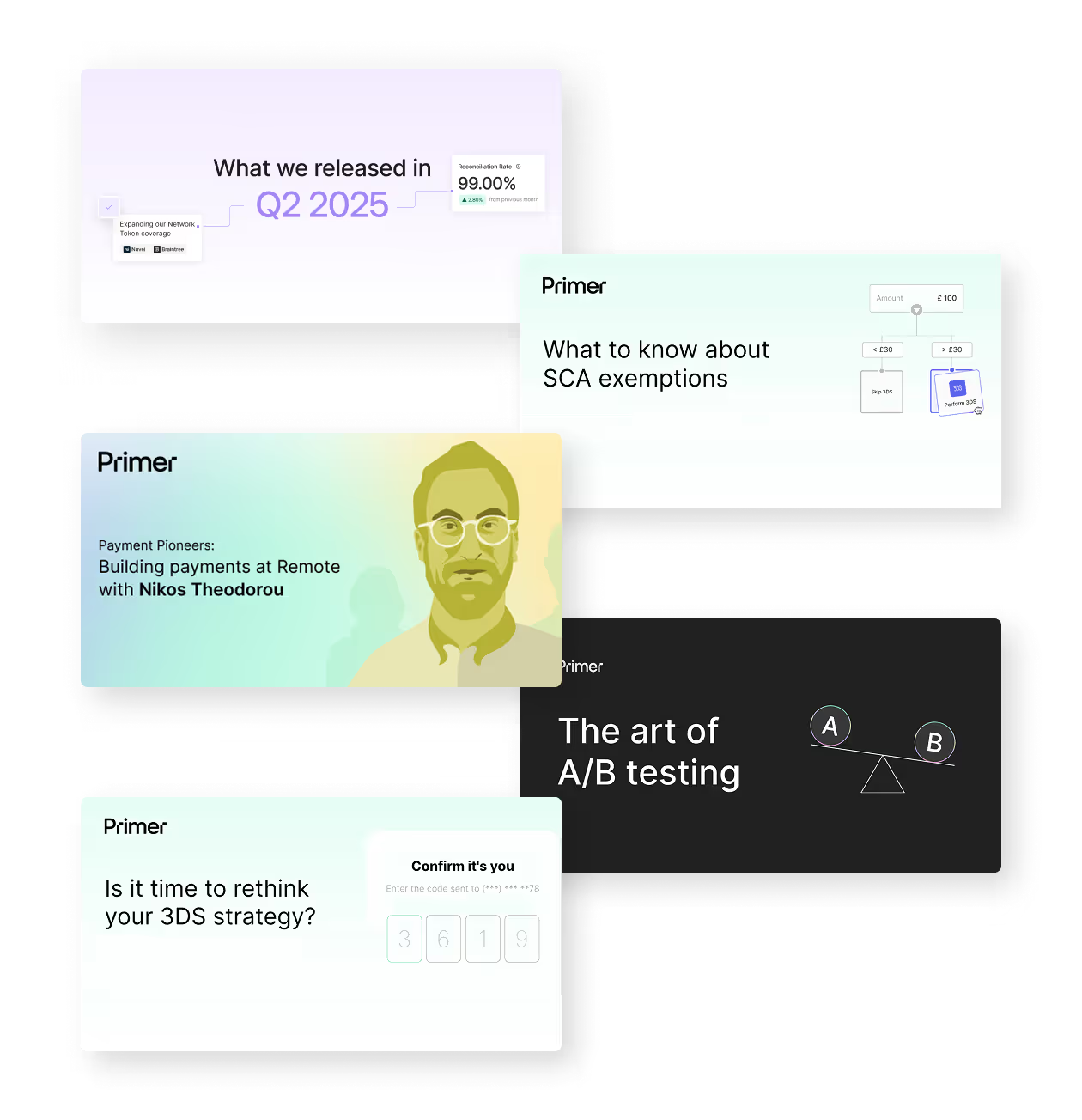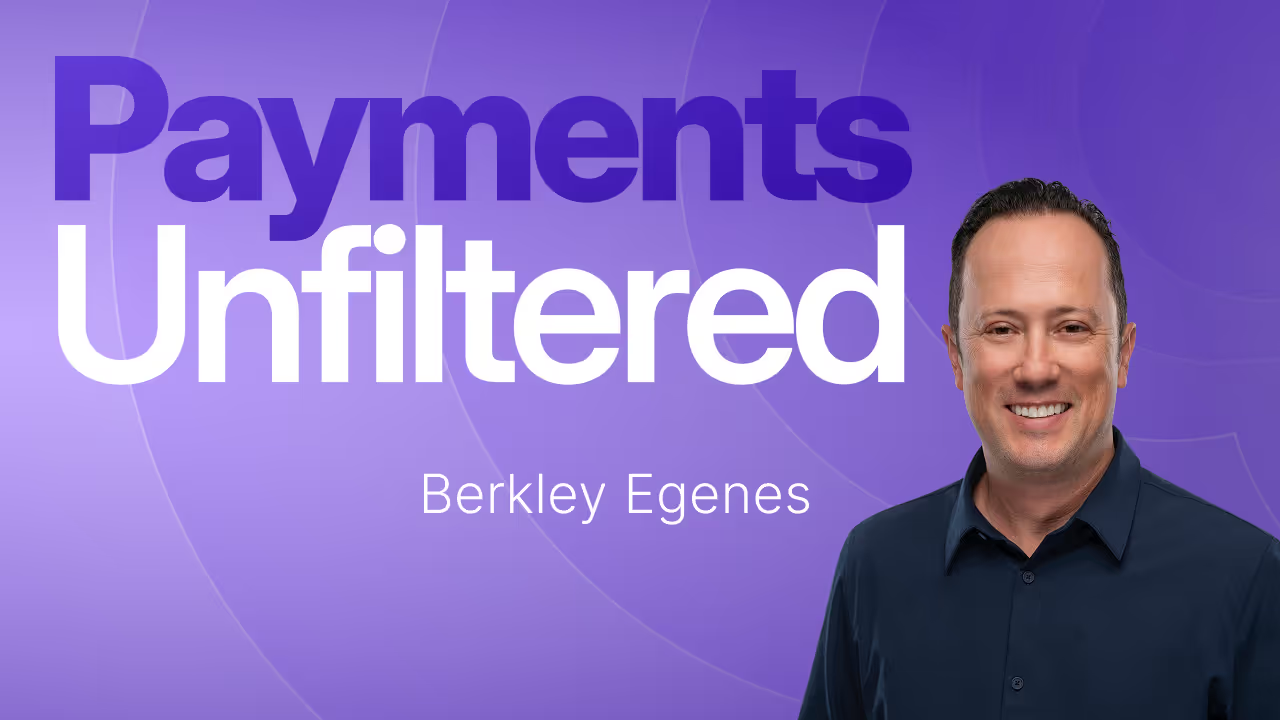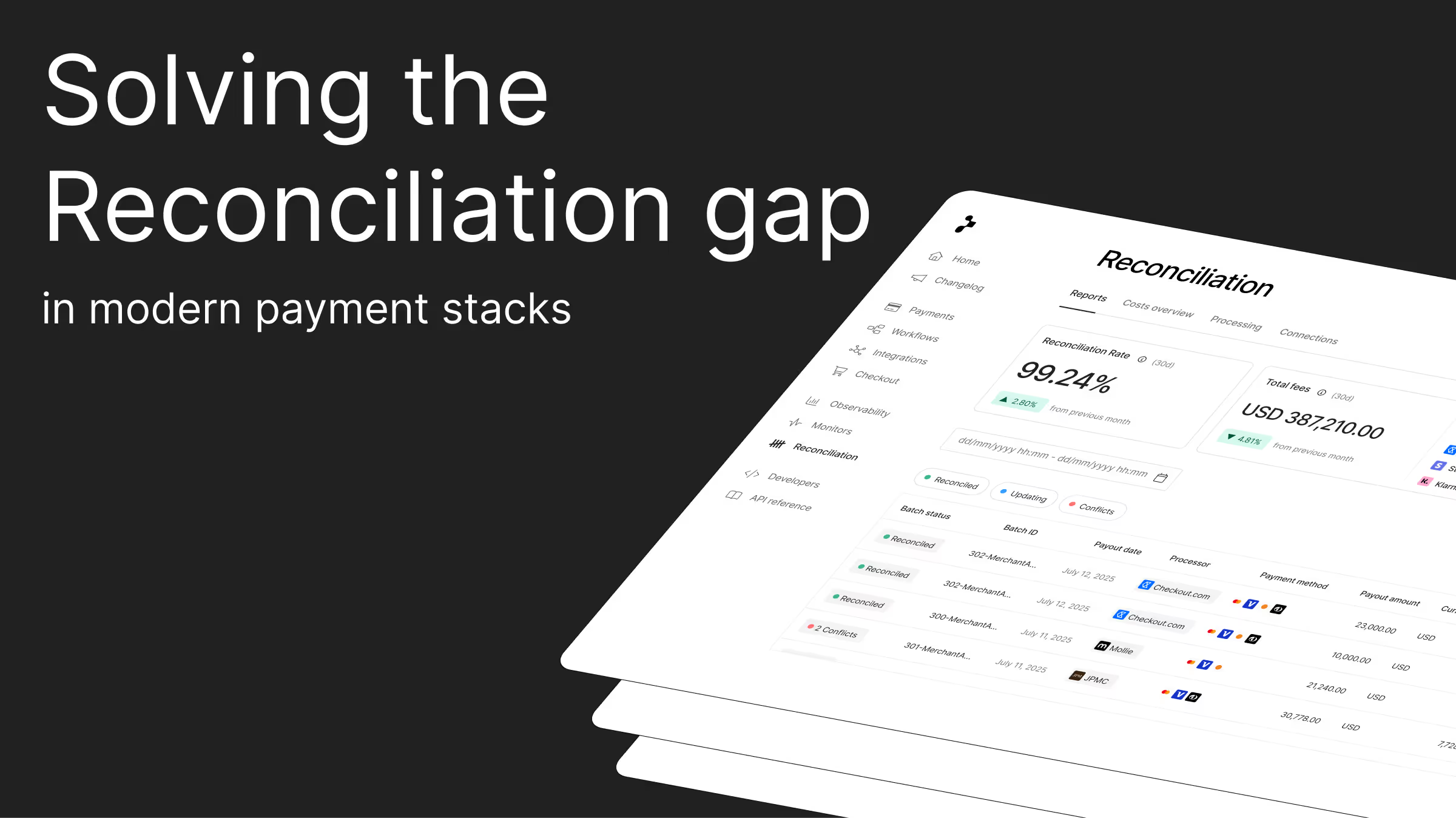There comes a point in every merchant’s growth where a single payment gateway isn’t enough.
Maybe you’ve been hit with an outage during a peak sales period, or expanded into a new market only to find you can’t offer critical local payment methods.
The obvious fix is to add more gateways. More redundancy, better coverage, fewer risks.
But each new provider adds more code, testing, contracts, and maintenance. Performance fluctuates. Routing needs constant adjustment. Suddenly your engineers are troubleshooting payments instead of building your product.
That’s why merchants are turning to payment orchestration. With a single integration, you can connect to multiple gateways and PSPs, automate routing, and scale payments without the technical burden.
So how does it work, and why is it the smarter path forward? Let’s break it down.
Ready to manage every payment gateway with just one integration and minimal maintenance? Book a call with Primer now.
Why you need multiple payment gateways
A payment gateway securely captures and transmits a customer’s payment details to the payment processor, which then communicates with the acquiring bank and card networks.
Relying on just one gateway is a risk. Here’s why you need more than one:
1. Reduce risk of failed payments with redundancy
Relying on a single payment gateway creates a single point of failure. If it goes down, even for a few minutes, you lose revenue.
With multiple gateways, you can instantly reroute traffic when there’s downtime or latency. Go further, and you can set up automatic retries: if a payment fails, it’s silently sent through a backup gateway. Instead of an error screen ending the sale, orchestration keeps the transaction moving and the customer none the wiser.
2. Expand globally by offering local payment methods
Customers expect to see the payment methods they know and trust at checkout, such as iDEAL in the Netherlands or PayNow in Singapore. If you don’t support local payment methods, you’re leaving revenue on the table.
A 2025 study by Baymard looked at why consumers abandon purchases: they found that 10% of customers abandoned their carts when their preferred payment method wasn't available.
No single gateway covers every local option. If you want to meet customer expectations everywhere you sell, you need access to multiple gateways.
3. Boost performance and profitability through smart routing
Global providers promise broad coverage, but they rarely deliver the best performance, localization, or cost efficiency everywhere. A domestic card, for example, often clears faster and cheaper with a local acquirer than with a global one.
Stick with a single gateway and you miss those advantages. With multiple gateways, you can route each transaction the best way, optimizing for speed, cost, and success rates.
4. Increase resilience against provider-specific rule changes
A single gateway can change its risk settings, fraud rules, or compliance requirements at any time, often without warning. This is a problem high-risk merchants often have to contend with.
For example, in iGaming, a payment gateway may tighten its risk appetite and decide an operator no longer fits its criteria. Securing a new payment gateway can take months, with contracts to negotiate and technical integrations to complete, leaving players unable to deposit in the meantime.
With multiple providers, you can shift volume quickly to maintain performance while you adapt.
5. Gain negotiating power with PSPs
With only one gateway, you have little leverage in contract and pricing negotiations, since switching providers is time- and resource-intensive.
For example, if your sole provider raises fees or changes settlement terms, you may have no choice but to accept because securing a new gateway takes too long to negotiate and integrate. By distributing volume across multiple gateways, you keep relationships competitive and can push for better rates and terms.
6. Comply with regional regulations more easily
Some markets have unique licensing, compliance, or data residency requirements that global gateways may not be able to meet. Adding compliant regional gateways lets you enter those markets more quickly, without navigating additional legal or technical complexities.
Read more: Why you need multiple payment processors (and how to do it)
The challenges of integrating with multiple payment gateways in-house
Many merchants see the value of using multiple gateways but ultimately stick with just one because the alternative, building and managing each integration in-house, comes with major challenges, such as:
- Managing separate integrations for each provider
Each gateway comes with its own API structure, documentation quirks, authentication methods, and update schedules. Your engineering team needs to write custom code for each one, keep up with changes, and test every update to avoid impacting live transactions. - Routing and retries require custom logic
If you want to route payments by country, currency, card type, or provider performance, you need to build that logic manually across multiple gateways. That includes setting fallback rules, handling edge cases, and maintaining conditional logic that becomes harder to update, test, and debug as your payment stack grows in complexity. - Slow rollout of new gateways or payment methods
Every new integration involves development time, stakeholder coordination, and extensive testing. Launching in a new region or supporting a new payment method can take months instead of days. This can significantly hinder your market expansion plans. - Fragmented data and reporting
With each gateway offering its own dashboard, metrics, and formats, your payment data lives in silos. With no central view, your team wastes time reconciling spreadsheets instead of spotting trends and optimizing performance. - Increased operational risk
As your setup grows, so does your risk. More gateways means more moving parts: more code to maintain, more room for errors, and more time spent firefighting outages, webhook issues, or mismatched transaction states across your payment systems.
But there’s a way around these challenges: payment orchestration, a layer of technology that lets you add miltiple gateways and PSPs without the technical lift. With a single integration, you can connect to any gateway or PSP, manage all your logic centrally, and adapt your payment stack with just a few clicks.
Why payment orchestration beats building in-house
Payment orchestration brings all your payment providers, methods, and services into a single, centralized layer. Instead of managing separate integrations, you connect once and control everything from one dashboard.
In practice, that means you can activate new PSPs or payment methods in minutes, not months. Orchestration eliminates ongoing integration work, reduces dependency on a single vendor, and gives you the freedom to add or switch providers whenever you need. More options mean more flexibility in your strategy, and more leverage at the negotiating table.
Read more: What is payment orchestration and how can it maximize payment efficiency?
How to integrate with multiple payment gateways using Primer
The online payments landscape has never moved faster. New gateways, payment methods, and compliance requirements appear constantly, yet most merchants are still stuck with legacy setups that make even small changes a headache.
Integrating a new gateway often feels like starting from scratch: contracts to sign, new APIs to learn, custom code to write, testing to complete. What should be a quick addition turns into a multi-month project, draining engineering time and slowing your ability to move into new markets.
Primer was built to break this cycle. Instead of wrestling with fragmented systems and rigid integrations, you get a single, unified payment infrastructure: one layer that connects every gateway, processor, and tool you need.
For example, here’s how easy it is to add a new payment gateway to Primer:
- Select the gateway you want to add
- Link your merchant account with API keys or credentials
- Switch on the payment methods you want to offer
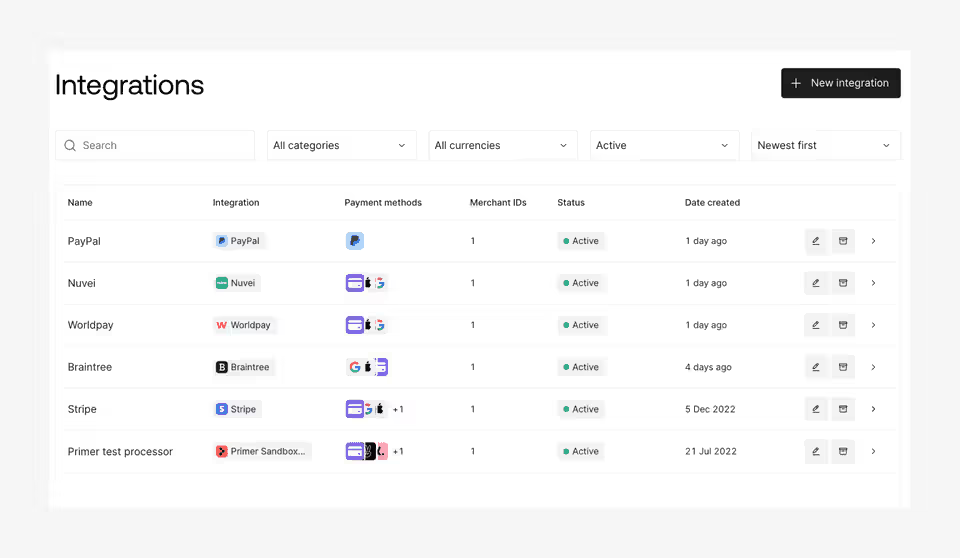
That’s it. You can implement a new gateway and get started in minutes, with no engineering sprints required.
What else can you do with Primer?
The real value isn’t just connecting PSPs and gateways. It’s what you can do once they’re connected.
With Primer, providers stop being just a way to accept payments and become tools for optimization, levers you can pull to improve performance, cut costs, and grow revenue.
For instance, you can use:
- Workflows to route each transaction to the provider with the best coverage, lowest fees, or highest success rate in a given market.
- Fallbacks to automatically retry failed payments with a backup provider of your choice, recovering revenue that would otherwise be lost.
- Custom 3D secure flows and integrated fraud tools to control when to reduce friction for customers and when to apply stronger checks.
Primer makes this possible by standardizing the language of payments across every provider. Instead of juggling different APIs, response codes, or data formats, everything is normalized into one framework, so you can set routing rules, retries, and fraud controls directly in Primer.
Measure how your gateways are really performing with Observability
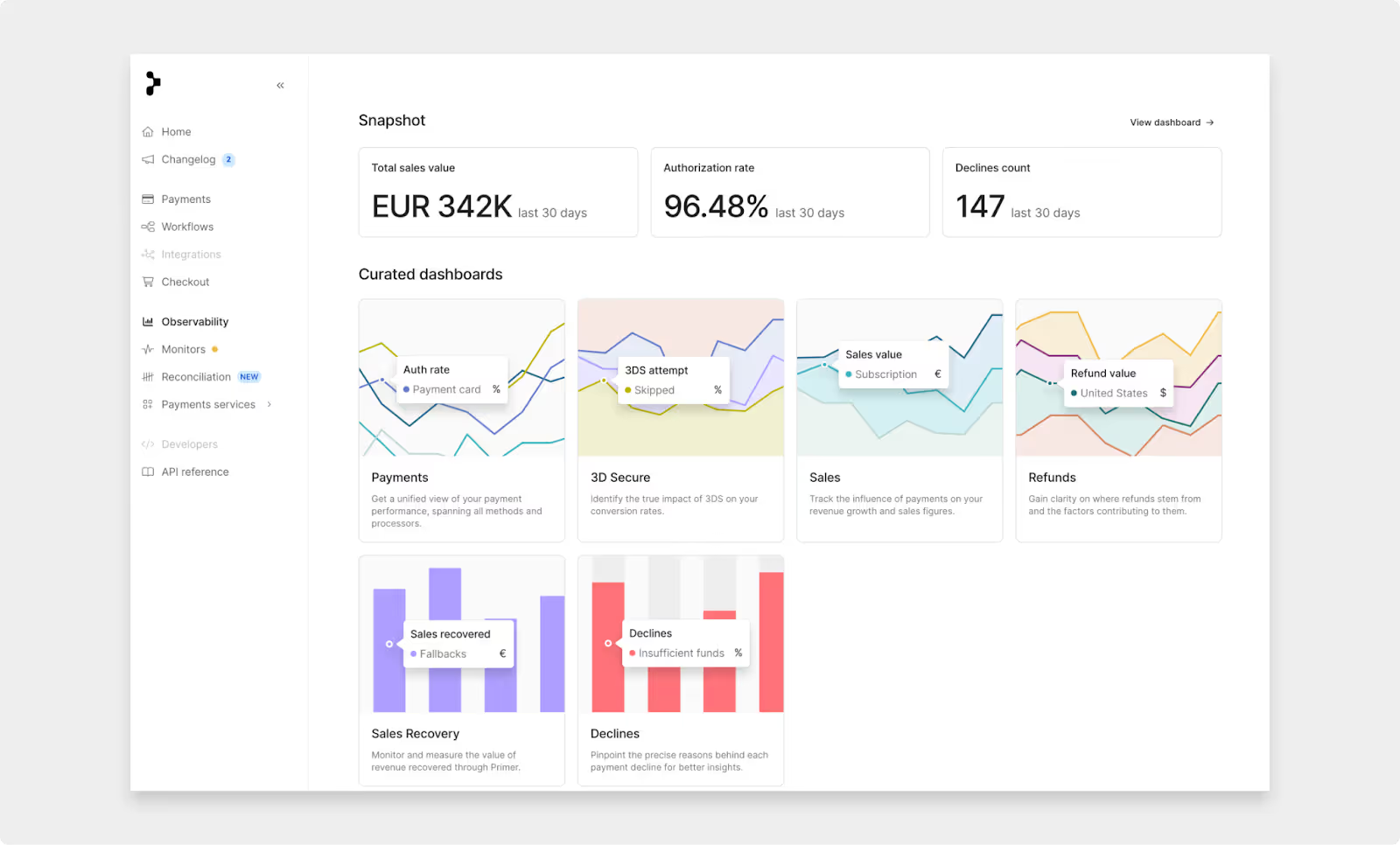
As you add more gateways to your payment stack, you need to know whether they’re delivering results. The data is there, but it’s often scattered across different dashboards and spreadsheet exports that take hours to reconcile.
Primer Observability unifies and standardizes payment data across all of your gateways, payment processors, methods, and services. You get 100+ visualizations, 30+ filters, and seven custom dashboards, all with a single login.
With Observability, you can:
- Spot trends and anomalies across providers
- Track the impact of routing or payment method changes
- Share performance insights and recommendations with leadership and stakeholders
You can also:
- Set up Monitors to get real-time alerts and stay ahead of issues without logging in
- Use Split Utility to A/B test and compare gateways or configurations side-by-side
Read more: The art and science of A/B testing in payments
How Ego is Saving €30,000 a month in fees and boosting conversion rates with Primer

Ego, a leading fashion brand in Europe and the U.S., launched a new mobile app that beat revenue forecasts by more than 20%. But growth exposed a problem.
Ego’s agreement with a single payment service provider was based on lower volumes, locking the brand into high fees with no leverage to negotiate better rates. Switching providers wasn’t an option without significant engineering investment.
Primer changed that. Within 48 hours, Ego had a working version of its new setup, and just seven days after signing, the brand went live with its new PSP.
“It felt almost suspiciously smooth,” said Manuel Perez, Head of Software Engineering.
Now Ego saves about €30,000 a month in fees, or hundreds of thousands a year to reinvest in growth. Conversions are up 10% on the app with Primer’s default drop-in checkout, and the team is only beginning to optimize their payment experience.
Read the full case study here: How Ego saved €30K a month, and gained complete control over its payments
Ready to integrate once and get all the gateways you want?
Integrating with multiple payment gateways in-house can mean missed opportunities and slower growth. Primer removes the technical tedium and gives you the tools to power a better payment strategy.
Book a demo to see for yourself.
FAQ: Integrating with multiple payment gateways in 2025
How do I integrate multiple payment gateways?
You can either build custom integrations for each gateway, which is complex and resource-heavy, or use a payment orchestration platform. Orchestration lets you connect once, then manage all gateways and logic centrally, without additional code.
What is payment orchestration?
Payment orchestration connects all your gateways and services through one integration. It simplifies scaling, enables dynamic routing and retries, and gives you full control over your payment stack. Platforms like Primer also enable you to customize the checkout experience, without any coding.
How do I add a new payment gateway?
Manually, you’ll need custom development, testing, and compliance work. With payment orchestration (for example, Primer), you just select the gateway, add credentials, and go live in minutes.
Why should I use more than one payment gateway?
Using multiple different gateways gives you coverage, redundancy, and flexibility across markets and payment methods. They help reduce failed payments, boost conversions, and improve negotiating power with providers.
What are the risks of using a single payment processor?
A single provider creates a single point of failure. If they experience downtime, change rules, or raise fees, you’re stuck. This limits flexibility, slows expansion, and increases operational risk.
